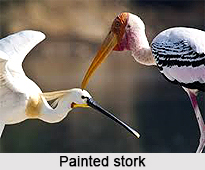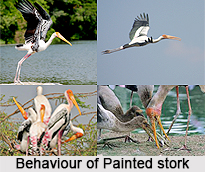 Painted stork with a scientific name "Mycteria leucocephal", is a large wading bird in the stork family.
Painted stork with a scientific name "Mycteria leucocephal", is a large wading bird in the stork family.
Concentration of Painted Stork
Painted stork is found in the wetlands of the plains of tropical Asia south of the Himalayas in the Indian Subcontinent and extending into Southeast Asia. Their distinctive pink tertial feathers give them their name. They forage in flocks in shallow waters along rivers or lakes. They immerse their half open beaks in water and sweep them from side to side and snap up their prey of small fish that are sensed by touch. As they wade along they also stir the water with their feet to flush hiding fish. They nest colonially in trees, often along with other water birds.
Sounds of Painted Stork
The only sounds of Painted stork produce are weak moans or bill clattering at the nest. They are not migratory and only make short distance movements in some parts of their range in response to changes in weather or food availability or for breeding. Like other storks, they are often seen soaring on thermals.
Structure of Painted Stork
Painted stork has a heavy yellow beak with a down-curved tip that gives it a resemblance to an ibis. The head of the adult is bare and orange or reddish in colour. The long tertials are tipped in bright pink and at rest they extend over the back and rump. There is a distinctive black breast band with white scaly markings. The band continues into the under-wing coverts and the white tips of the black coverts give it the appearance of white stripes running across the under-wing lining. A painted stork carries material for its nest. The underwing lining is clearly visible.
Body of Painted Stork
The rest of Painted Stork is whitish in adults and the primaries and secondaries are black with a greenish gloss. The legs are yellowish to red but often appear white due their habit of urohidrosis or defecating on their legs especially when at rest. The short tail is black with a green gloss. For a stork, it is medium-sized, standing about 93-102 cm tall, 150-160 cm in wingspan and weighing 2-3.5 kg (4.4-7.7 lbs). The males and females appear alike but the males of a pair are usually larger than the female.
Skin of Painted Stork
The downy young are mainly whitish with grey bills and blackish facial skin. The juveniles assume a brownish plumage and like most other storks reach breeding condition after two to three years. Like all storks, they fly with their neck outstretched. They often make use of the late morning thermals to soar in search of foraging areas.
Migration of Painted Stork
Painted Stork is widely distributed over the plains of Asia. They are found south of the Himalayan ranges and are bounded on the west by the Indus River system where they are rare and extend eastwards into Southeast Asia. They are absent from very dry or desert regions, dense forests and the higher hill regions. They are rare in most of Kerala and the species appears to have expanded into that region only in the 1990s. They are mainly seen on freshwater wetlands although they sometimes forage on the coast. They are resident in most regions but make seasonal movements. Young birds may disperse far from their breeding sites and a juvenile ringed at a nest in Keoladeo Ghana National Park, Rajasthan was recovered 800 kilometres away in eastern India.
Feedings of Painted Stork
Painted storks feed in groups in shallow wetlands. The preferred depth is about 12 to 25 cm of water and deeper waters are avoided. They feed mainly on small fish which they sense by touch while slowly sweeping their half open bill from side to side while it held submerged. They walk slowly and also disturb the water with their feet to flush fish. They also take frogs and the occasional Snake. They forage mainly in the day but may forage late or even at night under exceptional conditions. After they are fed they may stand still on the shore for long durations.
Breeding of Painted Stork
Painted stork breeds in trees along with other water birds. The platform nests are typically placed in a tree on an island or in an otherwise undisturbed area. The best nesting sites are at the tops of the trees and birds jostle for these locations. In some areas where they have been left undisturbed they nest very close to human habitations. The breeding season begins in the winter months shortly after the monsoons. In northern India, the breeding season begins in mid-August while in southern India the nest initiation begins around October and continues till February and or even until April. A lot of variation is noticed in the onset of breeding across sites with the season at Kokrebellur and Edurupattu around January or February but at Telineelapuram, Kundakulam and Tirunelveli the breeding begins around October or November.
Predation of Eggs by Painted Stork
Predation of eggs is mainly by crows and while very young chicks were sometimes attacked by crows, the older chicks were attacked by black kites. The typical clutch varies from two to five eggs with early breeders having larger clutches. The young chicks, when threatened, disgorge food and feign death by crumpling to the nest floor. The incubation period is about a month while the fledging period is nearly two months. The occasional predation of chicks by migrant Aquila eagles has been observed. During the mid-day heat, the adults of Painted stork will stand at the nest with wings outstretched to shade the chicks. To feed chicks, adults regurgitate fish that they have caught and these are typically smaller than 20 cm long. The daily requirement for chicks has been estimated to be about 500 grams made up of about 9 fish fed in two sessions.



















